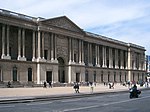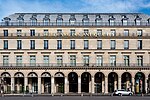Oratoire du Louvre

The Temple protestant de l'Oratoire du Louvre, also Église réformée de l'Oratoire du Louvre, is a historic Protestant church located at 145 rue Saint-Honoré – 160 rue de Rivoli in the 1st arrondissement of Paris, across the street from the Louvre. It was founded in 1611 by Pierre de Bérulle as the French branch of the Oratory of Saint Philip Neri. It was made the royal chapel of the Louvre Palace by Louis XIII on December 23, 1623, and was host to the funerals of both Louis and Cardinal Richelieu. Work on the church was suspended in 1625 and not resumed until 1740, with the church completed in 1745. It was suppressed in 1792 during the French Revolution, looted, stripped of its decor, and used to store theater sets. In 1811, it was given by Napoleon to the Protestant congregation of Saint-Louis-du-Louvre when that building was demolished to make way for the expansion of the Louvre. A statue and monument of Admiral Gaspard de Coligny, the great Huguenot leader of the 16th century, was built on the rue de Rivoli end of the church in 1889. It continues as one of the most prominent Reformed congregations in Paris, noted for its liberal theology. The closest métro station is Louvre – Rivoli.
Excerpt from the Wikipedia article Oratoire du Louvre (License: CC BY-SA 3.0, Authors, Images).Oratoire du Louvre
Rue Saint-Honoré, Paris Quartier Les Halles (Paris)
Geographical coordinates (GPS) Address Phone number Website External links Nearby Places Show on map
Geographical coordinates (GPS)
| Latitude | Longitude |
|---|---|
| N 48.861861111111 ° | E 2.3403055555556 ° |
Address
Temple de l'Oratoire du Louvre (Église réformée de l'Oratoire du Louvre)
Rue Saint-Honoré
75001 Paris, Quartier Les Halles (Paris)
Ile-de-France, France
Open on Google Maps










